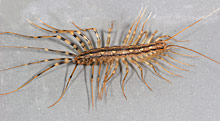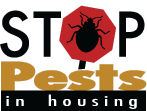Occasional Infesters
How to deal with occasional infesters
 |
|
Booklouse. USDA ARS. |
 |
|
Silverfish. Photo by Gary Alpert, Env. Health & Safety, Harvard U. |
 |
|
House centipede. Photo by Gary Alpert, Env. Health & Safety, Harvard U. |
They need warmth and moisture. Keep up with your routine vacuuming and take measures to dehumidify and your problem will probably go away.
If the problem isn't going away and you're seeing more than three at once, consider calling a pest management professional.
What they look like
The booklouse (a.k.a. psocid), silverfish (a.k.a. firebrat), and the house centipede are all insects that will occasionally set up shop in a home. Booklice are rice-sized. Silverfish have three tails and are silvery colored. House centipedes have lots of legs—one pair on each of their body segments—and they scoot fast.
Where they live
They like warm damp areas. They will appear in bathrooms, getting stuck in the tub or sink. The basement is a common headquarters.
What they do
Their look—worrisome to a few—is the extent of their threat. They're infesters because they'll go through their whole life cycle in your house—feeding along the way. The house centipede—arguably the creepiest of the three—is actually beneficial. It eats other creepy crawlies in your home.
Booklice like to eat mold and other fungi. They don't usually get to the point where they damage books.
Silverfish find a way to survive on all sorts of stuff: paper, fabric, stains, and wallpaper. The damage they cause won't be noticeable if you rarely see them.
Resources
See results from the Northeastern IPM Center's resources database.
